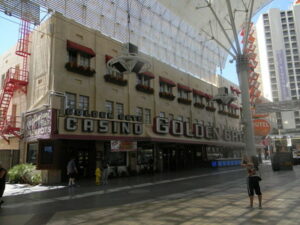
The Las Vegas Strip is, for many people, the mecca of the gambling world. It plays host to a large number of casino establishments, and many people visit it every year. These casino resorts provide masses of games and gambling experiences. Yet they also offer entertainment, dining, wine and cocktail bars, and much more. Las Vegas hasn’t always been this way, though. It only became the gambling hub that it is today in the last century. Of course, there has to be one casino that kicked all that off.
Here, we aim to take a look at the first Las Vegas casino. Not only that, but we want to find out how Vegas became what it is today. How would such a small stopover between Los Angeles and Salt Lake City grow to such a vast city? Everything led to the creation of The Strip, which is today’s bustling gambling centre. Many of the world’s largest casino, hotel and resort properties exist there. What was the first casino to give the town a swift kick-start?
The History of Las Vegas and Its Casinos
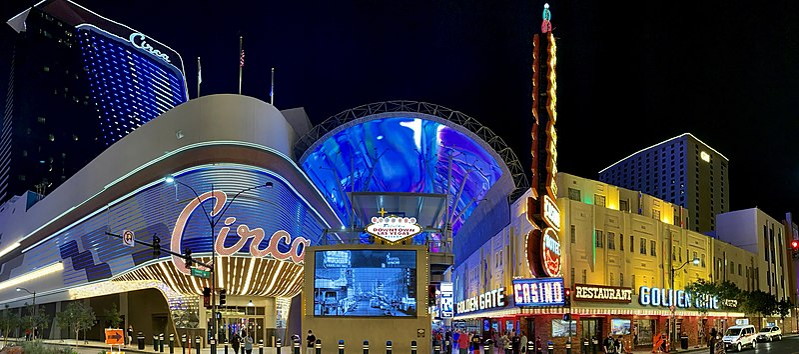
Las Vegas was first founded as a city in May 1905. It was at this point that the Los Angeles and Salt Lake railroad company sold 110 acres of land. That land laid next to the Union Pacific Railroad tracks. By 1911, Vegas became incorporated as a city, which gives you an idea of its swift growth.
It was only one year after Vegas was set up that it opened its very first casino. That casino was the Golden Gate, which served as a hotel-casino. It had its base at 1 Fremont Street, and visitors could buy bed and board for $1. Las Vegas remained as a railroad town for several years until the 1911 vote for incorporation.
How did the Golden Gate even become an entity in Las Vegas? Well, it all surrounds John F. Miller. He was among the first people to visit Vegas in 1905. It was during an auction for property in the future downtown area that Miller took action. He purchased a $1,750 parcel, standing at the corner of Main Street and Fremont Street. It was on this property that he set up the Miller Hotel. In its initial stages, it served as a temporary tent hotel, which also went by the name of the Hotel Nevada. Later on in the same year, he revealed plans to build a two-storey hotel structure there. In September, the Miller Hotel was the first in Vegas to receive plumbing.
January 13, 1906: John Miller’s Hotel Nevada (1 Fremont St at Main) was open for business. This is the original form of today’s Golden Gate Hotel & Casino. Here’s a timeline: https://t.co/EuE8zmsInT pic.twitter.com/CnPdgAX8g3
— Vintage Las Vegas (@summacorp) January 13, 2022
Miller wanted his hotel to have all the modern amenities of the time. This included heating, electricity and telephones. The new two-storey Nevada Hotel opened in January of 1906. The luxury hotel rooms received much praise, and the venue gained swift popularity. Upon opening as such, the hotel had also added a casino for guests. A third storey then came about in 1907, incorporating a kitchen and four more bedrooms. It also had its first telephone installed in the same year.
The casino saw some success throughout its initial years of operation. It continued providing gambling to guests of the hotel until 1909. Unfortunately, Nevada saw gambling banned throughout the state the same year. This meant that the blackjack and poker tables inside ended up in storage. The hotel continued providing lodgings and other services as the years went on.
The Nevada Hotel may have experienced popularity since opening. Yet Vegas itself remained quite a quiet place on the whole for 20 years. That was despite its new status as a city since 1911. In 1931, two things managed to kickstart the transformation of the city into what we know it as today.
Divorce Laws, the Hoover Dam and Re-Opening of Casinos Bring Fame and Fortune to Vegas
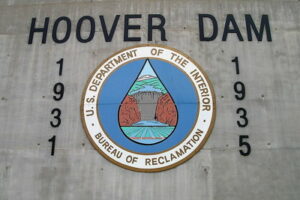
There is little doubt that 1931 was a pivotal year for Las Vegas. First of all, changes occurred in the area’s divorce laws. Through them, anyone who had been a resident of Vegas for six weeks could file for divorce. This meant that many “divorce tourists” decided to visit the city to separate from their partners.
At the same time, 1931 saw the legalisation of gambling in Nevada again. With this, the Nevada Hotel re-opened its own casino. The blackjack and poker tables returned to the establishment, providing even more incentive. Not only that, but this was the year that construction began on the nearby Hoover Dam. Situated in the Black Canyon of the Colorado River, it brought many people to Vegas. Construction workers brought their families along with them in the move. In fact, this helped Las Vegas avoid any extreme economic impact during the Great Depression. The construction work finished in 1935.
In the almost five years that it took to build the dam, several other gambling venues opened in Vegas. Casinos and other entertainment establishments were available up and down Fremont Street. Many of them sold alcohol to patrons, despite this being illegal due to Prohibition. Within those venues, gambling would often take place as well. Prohibition, of course, came to an end in 1933. As a result, both gambling and alcohol began bringing big money into Las Vegas.
While the Nevada Hotel and casino remained open from 1931, it rebranded to the Sal Sagev. Odd name, you may be thinking. Well, yes, but it comes from Las Vegas, only spelled backwards. The hotel and casino expanded to four storeys in the same year.
The Golden Gate Comes to Life
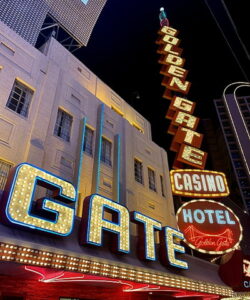
The Sal Sagev’s casino proved popular with guests throughout the proceeding years. It was in July of 1955 that Abe Miller, John F. Miller’s son, received planning approval. He intended to lease the ground floor of the hotel to a 23-man group. They would then sub-lease that for $25,000 per month to eight Italian-American men. It was these eight men who planned to open up the Golden Gate casino there. Renovations began in that same month, all financed by the 23-man group. Those renovations reportedly cost $330,000. Abe Miller was to receive $2,300 per month and 5% of all gambling costs from the casino.
It was later on in 1955 that the Golden Gate casino (named after the bridge of the same name) opened. One of the eight sub-leasers of the casino, Italo Ghelfi, operated it for almost 40 years. The hotel retained the Sal Sagev name.
Two years later, John F. Miller died aged 92 while taking a nap in his apartment. Abe Miller took over the running of the Sal Sagev into the ’60s, making several alterations throughout.
It was in 1974 that the entire property became the Golden Gate Hotel and Casino. Both Abe Miller and his sister had died by 1985. The latter willed her small ownership in it to The Convent of the Good Shepherd of Las Vegas. Ghelfi and his family purchased the property from the partnership in 1990. The establishment then marked its 90th anniversary in May 1996.
Another renovation occurred in 2005 under the ownership of Mark Brandenburg, Ghelfi’s son. Brandenburg later went on to become the owner of the property. It then went through a major renovation in 2012, costing $12 million. Then, in 2016, Greg and Derek Stevens became the full owners of the Golden Gate.
An expansion to the casino began in February of 2017. This would take its footprint into the space vacated by the La Bayou casino. Golden Gate closed on August 21 of that year to accommodate for the changes. It ended up doubling the size of the venue, adding 100 new slot machine games to the floor. At the same time, it incorporated a new casino entrance. The Golden Gate re-opened only four days later. It also incorporated a sportsbook with permission of the Nevada Gaming Control board in June of 2019.
The Influence of the Golden Gate on The Strip
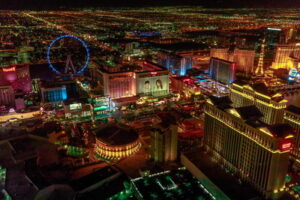 The arrival of the Nevada Hotel with its casino doubtless had an influence on Las Vegas. The Northern Club was one venue based in Vegas that opened as a coffee house in 1913. It was in 1920 that it began selling illegal alcoholic drinks and gambling games. This venue actually went on to become the La Bayou in 1999. What’s more, it was this venue that received the first official gambling licence in 1931. Even more significant is that this was the first licence awarded to a woman – Mayme Stocker.
The arrival of the Nevada Hotel with its casino doubtless had an influence on Las Vegas. The Northern Club was one venue based in Vegas that opened as a coffee house in 1913. It was in 1920 that it began selling illegal alcoholic drinks and gambling games. This venue actually went on to become the La Bayou in 1999. What’s more, it was this venue that received the first official gambling licence in 1931. Even more significant is that this was the first licence awarded to a woman – Mayme Stocker.
Of course, The Mob began to establish themselves in the city at the start of the 40s. By 1941, mobster Bugsy Seigel had taken over control of the Northern Club. It was this that led to the creation of the Las Vegas Strip, though.
Siegel was one of the people who developed casinos on The Strip after the success of El Rancho. He had had some trouble with the law in Vegas, who knew of his mob connections. Because of this, the El Cortez on Fremont Street that he owned was suffering and he sought out a venue outside the city limits.
Siegel ended up meeting a man called Billy Wilkerson. He had plans to build the Flamingo resort on The Strip. Yet he needed funding for it, and Siegel (posing as a legit businessman) offered it to him. Through the deal, Siegel bought two-thirds of the Flamingo from Wilkerson. It didn’t take long for him to turn on Wilkerson though, threatening him so much he fled to Paris. This left Siegel with sole ownership of the Flamingo casino. The resort opened in 1946, although it flopped in its initial months. Various other Mob members re-opened it in 1947 to much more success, though.
The venue turned over profit of more than $4 million in 1948. This led to even more casinos opening up on The Strip, all owned by the Mob. The Frontier and the Sands were two of these venues, helping to build Vegas up to what it is today.
Fremont Street didn’t suffer at that time, either. Various notable players in the casino world opened their own venues to popularity and success. The Horseshoe Casino was one of these, opening in 1951.
With so many casinos and other gambling venues in Vegas, tourist numbers soared. By 1954, eight million people were visiting the area per year. Huge performers like Frank Sinatra and Elvis Presley also put on events there. Since that time, Las Vegas has gone from strength to strength. Even with the late ’70s introduction of Atlantic City in New Jersey, Vegas didn’t suffer too much. Yes, it had competition, but it didn’t flounder. Instead, Steve Wynn injected some much-needed revitalisation into Vegas.
He dreamed up The Mirage casino – a massive and lavish resort for gamblers. Managing to secure financial backing for it, it opened in 1989. This served as the first megaresort on The Strip, bringing in even more tourists to the city.
As a result of this venue, a massive construction boom occurred in the 1990s. A variety of other iconic casino resorts, such as the MGM Grand, Luxor, and Venetian, opened in that decade. It was these resorts that helped to usher Las Vegas into the 21st century. Many still stand today, being very recognisable as part of the city.
Without the idea of John F. Miller to create a hotel in 1905, would Las Vegas be what it is today? He introduced the very first casino to the city. Despite various issues, such as gambling bans and competition, it has grown to be a mammoth. Throughout it all, the Golden Gate remains standing to this day. Not only was it the first casino in Las Vegas, it remains as the oldest still operating. That’s quite the achievement, and may it continue providing games
